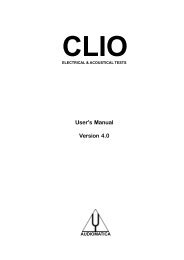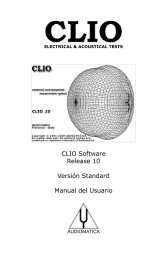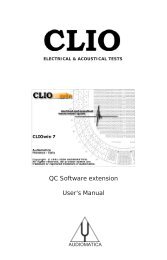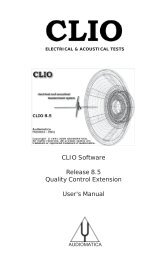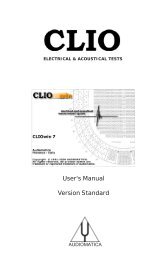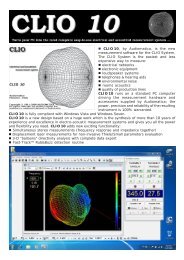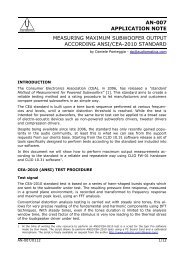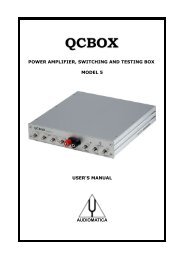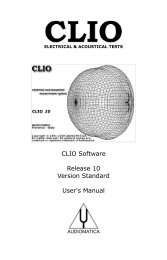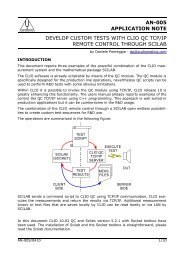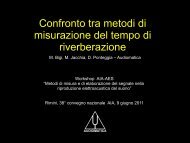CLIOwin 6.5 PCI User's Manual - Audiomatica Srl
CLIOwin 6.5 PCI User's Manual - Audiomatica Srl
CLIOwin 6.5 PCI User's Manual - Audiomatica Srl
Create successful ePaper yourself
Turn your PDF publications into a flip-book with our unique Google optimized e-Paper software.
We will take this opportunity to introduce the use of the Wrapped Check Box. Figures<br />
10.22 and 10.23 shows the tweeter phase curve, unwrapped and wrapped.<br />
110.0<br />
CLIO<br />
0.0<br />
110.0<br />
CLIO<br />
180.0<br />
dBSPL<br />
Deg<br />
dBSPL<br />
Deg<br />
100.0 -3312.0<br />
100.0 108.0<br />
90.0 -6624.0<br />
90.0 36.0<br />
80.0 -9936.0<br />
80.0 -36.0<br />
70.0 -13248.0<br />
70.0 -108.0<br />
60.0 -16560.0<br />
20 Hz<br />
100 1k 10k 20k<br />
60.0 -180.0<br />
20 Hz<br />
100 1k 10k 20k<br />
Figure 10.22 and 10.23<br />
Reader might wonder if these figures are correct at all and if they have same usefulness,<br />
at least visually. Well, the curves are absolutely correct; their visual usefulness is zero<br />
for the wrapped curve and low for the unwrapped. Difficulties in getting simple visual<br />
information from these curves arise because they are the sum two effects. The first one<br />
is the device own phase response. The second is the time of sound flight. The latter does<br />
affect the curves much more than the first one, completely burying it. The good news<br />
is that it is often possible to separate these two effects. However, bad news, this is not<br />
an easy task. Trying to explain it, without going in heavy math, is very difficult. The<br />
bibliography in this user manual should be considered as integral part of it here. Within<br />
CLIO the time of flight can be removed in several different way, with different degree<br />
of accuracy. The most accurate is also the most complicated and is how we are going<br />
to proceed. Fig. 10.24 introduces us to Minimum Phase, which is the hearth of the<br />
whole procedure.<br />
110.0<br />
CLIO<br />
180.0<br />
dBSPL<br />
Deg<br />
100.0 108.0<br />
90.0 36.0<br />
80.0 -36.0<br />
70.0 -108.0<br />
60.0 -180.0<br />
20 Hz<br />
100 1k 10k 20k<br />
Figure 10.24<br />
We obtained it selecting minimum phase in the MLS Setting and calculating the phase<br />
again. Certain well-behaved systems are defined as Minimum Phase. In these, the<br />
phase response can be obtained from the magnitude response by calculation. Another<br />
kind of phase (we promise is the last one), is Excess Phase. This is the algebraic<br />
difference between true phase, as in Fig.10.22, and minimum phase. It is exactly what<br />
we need to separate the time of flight from the device own phase response. We wont<br />
use excess phase directly here but a post process of it, Excess Group Delay. Fig.10.25<br />
is the excess group delay of our tweeter vs. frequency.<br />
Chapter 10 - MLS 97



